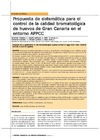Please use this identifier to cite or link to this item:
https://accedacris.ulpgc.es/jspui/handle/10553/9910
| Title: | Propuesta de sistemática para el control de la calidad bromatológica de huevos de Gran Canaria en el entorno APPCC | Authors: | Hernández Castellano, Lorenzo Sanjuán Velázquez, Esther Millán de Larriva, Rafael Carrascosa Iruzubieta, Conrado Mauricio Quintana, C. Pérez García, Esteban |
UNESCO Clasification: | 3109 Ciencias veterinarias | Keywords: | Huevos, pH Frescura APPCC Contaminación |
Issue Date: | 2007 | Journal: | Revista Canaria de las Ciencias Veterinarias | Abstract: | Se propone el análisis sistemático en el huevo, de parámetros microbiológicos, pH y unidades Haugh, como indicadores del estado de calidad en el producto final, incluidos como medida de control en el entorno de un sistema de APPCC en la producción de huevos de G.C. Se tomaron, durante 2 años, 314 muestras de huevos de 26 granjas avícolas de G.C. y se les midieron los parámetros propuestos, (en un plazo de 24 horas tras recogida). Los resultados mostraron un huevo de calidad microbiológica (2,23% positivos a aerobios mesófilos, 0,32%, a enterobacterias, 1,59%, a Enterococcus (Streptococcus faecalis), 0% a Salmonella spp.), muy aceptable, según los criterios recomendados. Además, los valores medios de pH (7,601 ± 0,36) y de UH (78,27 ± 8,9), que estuvieron situados en los rangos considerados como óptimo y bueno, respectivamente, para huevos frescos, hacen concluir que se oferta al consumidor un producto suficientemente salubre, estable y fresco, lo que podría incrementar su tasa de consumo, ante el aumento de confianza de los compradores. Se concluye la idoneidad de la sistemática propuesta como verificación del funcionamiento del sistema APPCC en huevos de G.C., y como indicadora de las medidas correctoras que habría que aplicar para garantizar la ausencia de peligros en el producto final. A systematic analysis for eggs is proposed by means of microbiologic parameters, pH and Haugh units (UH) evaluation, using them as indicators of quality state in the final product. This analysis would be included in HACCP system to produce eggs from G. C. 314 samples were obtained from 26 farms located in G.C. in a period of two years. The parameters proposed were measured in the next 24 hours after the sample obtention. The results show eggs with very acceptable microbiological quality (2, 23 % positives to mesophiles aerobic, 0, 32% positives to enterobacters, 1,59% positives to Enterococcus (Strep. faecalis) and 0% to Salmonella spp.) if they are compared to the references. Also pH values (7,601 ± 0,36) and the UH ones (78,27 ± 8,9) show that these eggs were into ranges classified as ideal and good respectively for fresh eggs. For this reason we can conclude that the eggs offered to the buyer are healthy, stable and fresh, so this result could increase the egg´s consumption, because the confidence in this product would increased too. Finally, we can say that this protocol is suitable to check the efficiency of the HACCP system in eggs from G.C., and also to indicate the corrective decisions to guarantee the no presence of hazards and risks in the final product. |
URI: | https://accedacris.ulpgc.es/handle/10553/9910 | ISSN: | 1696-1978 | Source: | Revista canaria de las Ciencias Veterinarias. Las Palmas de Gran Canaria: Servicio de Publicaciones, Universidad de Las Palmas de Gran Canaria, 2007-2008- .- ISSN 1696-1978. n. 4-5, p. 14 |
| Appears in Collections: | Rev. canar. cienc. vet. n.04-05, 2007-2008 Artículos |
Page view(s)
149
checked on May 18, 2024
Download(s)
698
checked on May 18, 2024
Google ScholarTM
Check
Share
Export metadata
Items in accedaCRIS are protected by copyright, with all rights reserved, unless otherwise indicated.
